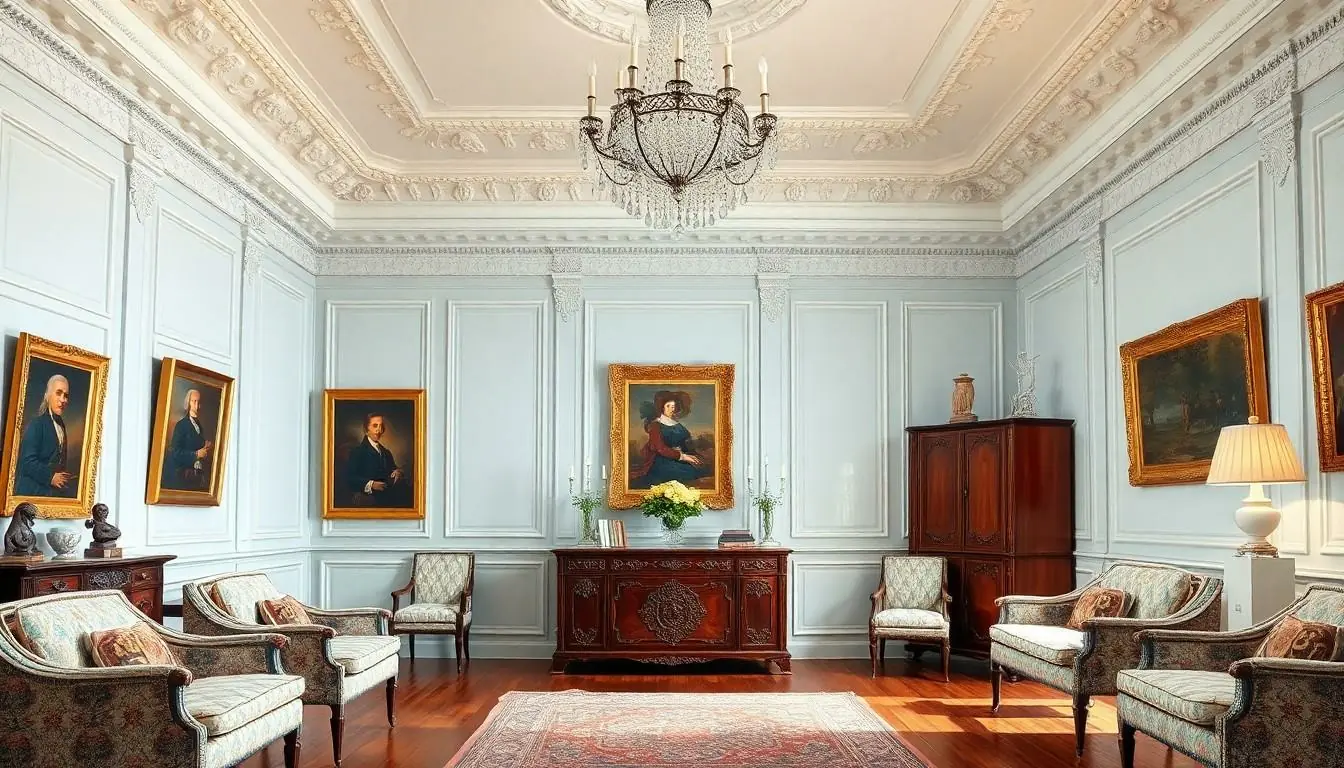Georgian interior design isn’t just a style; it’s a time machine that whisks you back to the elegance of the 18th century. Imagine walking into a room where every detail whispers tales of opulence and sophistication. From ornate moldings to plush upholstery, this design aesthetic marries grandeur with comfort, making it the perfect choice for those who want to impress their guests—or just their cat.
Table of Contents
ToggleOverview Of Georgian Interior Design
Georgian interior design embodies the elegance of the 18th century, showcasing a rich combination of luxury and comfort. Characterized by symmetry, this style emphasizes balanced proportions across spaces. Specific elements define Georgian interiors, including intricately detailed moldings, high ceilings, and ornate cornices.
Furniture pieces typically feature rich woods, such as mahogany and walnut, exhibiting sophisticated craftsmanship. Upholstery often boasts luxurious fabrics like silk and brocade, creating a sense of lavishness. The color palette tends to include soft pastels and muted earth tones, providing a serene backdrop for decorative elements.
Accessories play a crucial role in Georgian interiors. Portrait paintings and classical sculptures serve as focal points, contributing to the aesthetic’s grandeur. Chandeliers, usually made of crystal, enhance the overall opulence, illuminating spaces with a warm glow.
Flooring often consists of polished wood or intricately patterned tiles, adding to the richness of the design. Textiles, including heavy drapes and plush area rugs, soften the atmosphere while adding a layer of comfort.
The incorporation of architectural features also defines this design style. Arched doorways, grand staircases, and detailed fireplaces contribute to the overall grandeur of Georgian settings.
These timeless elements create a cohesive environment, appealing to those who appreciate historical elegance. Georgian interior design invites individuals to experience a refined lifestyle marked by sophistication and comfort.
Key Characteristics

Georgian interior design showcases distinctive features that embody elegance and refinement. This style relies on symmetry, proportions, and luxurious details.
Color Palette
Soft pastels dominate the Georgian color palette. Muted earth tones complement these lighter shades, creating a serene and inviting atmosphere. Shades like pale blue, soft green, and warm beige often appear on walls. Often, bold colors like deep burgundy and forest green serve as accents, enhancing visual interest. Color choices are strategic, promoting a sense of harmony throughout spaces. Decorative elements subtly incorporate these colors, enriching the overall ambiance.
Materials and Textures
Rich woods such as mahogany and walnut define the furniture in Georgian interiors. High-quality materials lend a luxurious feel, while lush fabrics like silk and brocade adorn upholstery. Textures vary, creating depth through layered fabrics and intricate patterns. Ornate moldings and cornices showcase craftsmanship that enhances architectural details. Polished wood flooring adds a warm touch, complemented by plush area rugs that provide comfort. Accessories like crystal chandeliers and fine art further elevate the sensory experience of the space.
Furniture Styles
Georgian interior design showcases a variety of furniture styles that reflect its elegance and sophistication.
Types of Furniture
Chaise lounges, wingback chairs, and richly carved sideboards typify Georgian furniture. Pieces often feature intricate carvings and curved lines, made from fine woods such as mahogany and walnut. Settees with tapered legs and cabriole feet serve as perfect complements to more ornate items. Desks and writing tables embody functionality while maintaining aesthetic appeal. Dining tables, often oversized, invite gatherings and conversations, enhancing the grandeur of the room.
Typical Fabric Patterns
Floral and damask patterns frequently adorn fabrics in Georgian interiors. Stripes and checks also emerge as popular choices, bringing an additional layer of visual interest. Upholstery often showcases luxurious silks, brocades, and velvets, enhancing comfort while emphasizing opulence. Rich color variations, including deep reds and soft greens, combine to create inviting atmospheres. These patterns narrate a story of refinement, intertwining history and craftsmanship within the space.
Architectural Elements
Georgian interior design showcases unique architectural features that define its elegance. A focus on ornate details and craftsmanship highlights the beauty of this style.
Moldings and Trim
Moldings and trim serve as essential elements in Georgian interiors. Intricate cornices decorate ceilings, creating visual interest and drawing the eye upward. Baseboards and chair rails often feature elaborate designs that enhance the space’s grandeur. These details contribute to a feeling of historic sophistication. Many homes also incorporate wainscoting, adding texture and depth to walls. Choosing rich woods for moldings reinforces the luxurious atmosphere typical of Georgian design. Every piece of trim reflects a commitment to craftsmanship that elevates the overall aesthetic of the home.
Fireplaces and Chimneys
Fireplaces and chimneys represent significant focal points in Georgian interiors. Often, they feature elaborate mantelpieces, showcasing intricate carvings and detailed moldings. These fireplaces provide warmth and act as gathering spots, enhancing the room’s comfort. Gas and wood-burning options present functionality alongside beauty. Many designs incorporate symmetrical elements, reinforcing the balance inherent in Georgian architecture. Surrounding the fireplace, decorative tiles often add color and pattern, further enriching the visual appeal. Overall, fireplaces contribute to the inviting atmosphere characteristic of Georgian homes, blending practicality with refined style.
Modern Adaptations
Contemporary designers frequently combine traditional Georgian elements with modern aesthetics to create fresh interior spaces. They introduce sleek lines and minimalist décor, balancing the classic grandeur of Georgian design with a more streamlined approach. Bold colors often punctuate the soft pastels typical in Georgian interiors, ensuring a vibrant atmosphere.
Furniture pieces retain Georgian influences, yet embrace contemporary materials like metal and glass. Designers incorporate clean, geometric shapes into seating and tables, emphasizing both comfort and functionality. Isolated accent chairs with modern upholstery can coexist alongside ornate settees, bridging the gap between historic charm and current trends.
Lighting fixtures also see a blend of styles, where traditional chandeliers are paired with modern pendant lights. Such combinations can create striking focal points that draw the eye while maintaining the elegance associated with Georgian design. Additionally, contemporary art pieces often adorn walls, injecting a sense of modernity into classic interiors.
Textiles undergo transformation as well. Luxurious fabrics such as velvet merge with modern prints, creating inviting spaces that resonate with both history and current fashion. Rugs featuring abstract designs can be layered over polished wood floors, offering a striking contrast to traditional detailing.
Innovative use of color also plays a crucial role in modern adaptations. Walls benefit from unexpected shades, like deep navy or charcoal, which enhance the sophistication of Georgian elements. This intentional use of color can dramatically alter the room’s ambiance while maintaining a nod to the past.
Architectural features receive thoughtful updates too. Modern windows, for example, may replace traditional styles, allowing natural light to flood interiors while preserving the symmetry and proportions characteristic of Georgian homes. Such adaptations reflect a commitment to keeping elegance alive in evolving taste and preferences.
Georgian interior design remains a timeless choice that effortlessly blends elegance with comfort. Its rich history and distinctive features create a warm and inviting atmosphere that appeals to many. By incorporating luxurious fabrics and intricate details, homeowners can achieve a sophisticated look that pays homage to the grandeur of the 18th century.
Modern adaptations of this classic style showcase its versatility, allowing for a seamless integration of contemporary elements. This evolution ensures that Georgian design continues to inspire and captivate, making it a relevant choice for those seeking to elevate their living spaces. Embracing this style not only enhances the aesthetic appeal of a home but also invites a sense of history and craftsmanship into everyday life.




